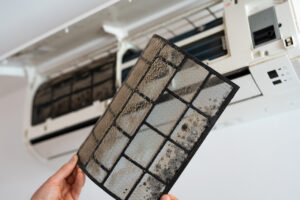 Mold prevention is one of the most popular conversations with our customers—and with good reason. Nobody wants mold setting up shop in their house and prevention is key when you have to deal with it.
Mold prevention is one of the most popular conversations with our customers—and with good reason. Nobody wants mold setting up shop in their house and prevention is key when you have to deal with it.
If you’re interested in learning some of the basic steps to take in mold prevention, you’ve come to the right place.
Use Your Common Sense(s)
Mold is very good at being invisible.
It can hide in small nooks and crannies, but if you know where to look, you can see it, and if you can’t get to where it might be hiding, you might even be able to smell it.
Mold has a very noticeable texture. It can range in color from gray to green to black, but it’s always going to have a cotton-like texture.
Have you ever left food in your fridge by accident and before you know it you have a science experiment on your hands? That fuzzy stuff on your food is mold, and sometimes it can look like that on your walls, too.
That’s not the only mold to look out for; mold can vary in what it looks like to looking somewhat fuzzy to almost appearing like white thread. If you do find visible mold growing somewhere in your house, it’s best to contact someone immediately so they can get a handle on the situation before it gets out of hand.
If your house has a musty odor, there’s a chance you have mold. Mold produces a gas that gives off a fairly distinct smell and if you smell mold, you’re also inhaling mold.
Use your eyes and nose, and you might be able to pinpoint the problem areas in your home. From there, you can decide if you’re able to tackle the mold prevention yourself or if it’s best to call in professionals.
Find the Moisture
The one thing that remains constant in any case of mold growth is the moisture. Mold needs moisture to grow. This seems like an obvious item to check off your mold prevention list, but there are places people don’t think to check.
Behind your furnace is a very popular place for moisture content to build up. Most people assume that a furnace is hot and dry, but with poor ventilation that heat can easily turn into humidity.
Another hot spot for moisture is in the attic. Again, I know the attic isn’t the first place that pops in your head when you think about moisture, but it’s actually one of the most common places for mold to be hiding. Moisture can slip in between your roof and your ceiling. Combine that with some poor ventilation and it’s the perfect recipe for moisture.
These are just a couple of spots where moisture can build up, but make sure you check throughout your house for any signs of moisture.
Getting to the Source
Once you’ve identified any possible places of moisture in your house, the next step in your mold prevention battle is to identify the source of the moisture.
Do you have a leak in your roof? Is water puddling in your bathroom after people shower or bathe? Do you have cracks in your foundation that have let small amounts of moisture seep in?
All of these are common issues with mold, but once they’re identified, you have a better idea of what to do for your next step.
Seal or repair the areas where moisture is seeping into your house. Sometimes this is simple and can be done by yourself and other times, you may need to call in some professionals to tackle the project.
Either way, blocking moisture from making its way into your house is a required step in mold prevention as a whole.
Questions on Mold Prevention
Did I miss any questions you may have for our team? If so, we’d love to hear from you. You can contact us anytime and we have a team of certified professionals who are more than willing to answer any questions you might have!
Photo by Mari Helin on Unsplash







